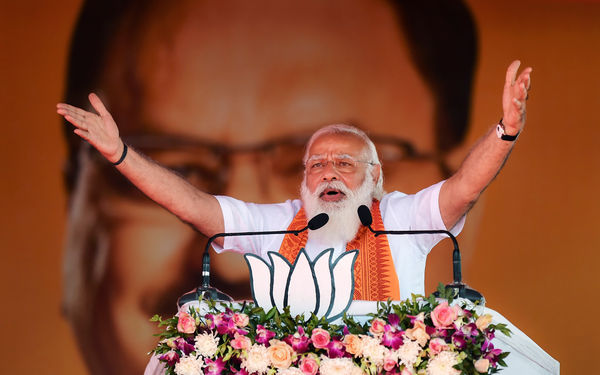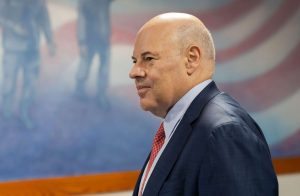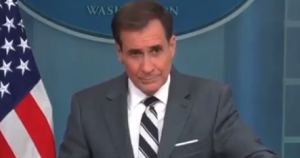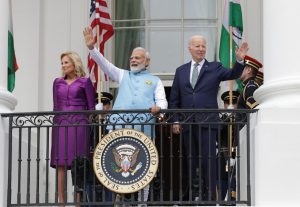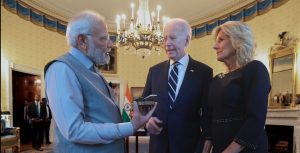Elections in Assam, West Bengal, Kerala, Tamil Nadu and Puducherry, dates for which were announced on February 26, are a mixed bag of prospects for Prime Minister Narendra Modi and the BJP.
Firstly, these states are outside the sphere of influence of political factors that are currently active in north India where the unrest by farmer bodies have dominated the narrative.
In terms of challenges, however, these polls constitute an important indicator of the shape of things to come before the next Lok Sabha polls due in 2024.
Of course, the polls that are due in Uttar Pradesh, Uttarakhand, Punjab and Gujarat in 2022 and those to be held in Karnataka, Madhya Pradesh, Chattisgarh, Rajasthan in 2023 are equally crucial for all players.
Also read: Lotus will bring ‘asol poribartan’ that Bengal youth aims for: PM Modi
However, in terms of a big national impact at this juncture, the elections in West Bengal hold the key to regrouping regional parties to challenge the BJP%u2019s domination ahead of the 2024 parliamentary elections.
Also read: From ‘Didi’ to ‘Beti’, decoding Mamata Banerjee’s new poll slogan
Even a sharp dip in the electoral strength of Mamata Banerjee%u2019s Trinamool Congress in Bengal, let alone a resounding defeat in the hands of the BJP, could signal the collapse of the last resistance to Modi%u2019s leadership since the 2014 Lok Sabha polls.
Conversely, the re-emergence of an unscathed Mamata Banerjee in Bengal in 2021 –despite a relentless and virulent pursuit by the BJP — could send out a loud and clear message that Modi faces a tough ride uphill in the 2024 elections. The opposition would be more than energised and united to regain space in the national narrative against the BJP.
Therefore, Modi has to ensure that the BJP vanquishes Mamata in her den by, at least. reducing her party%u2019s strength in terms of seats and, if possible, hope to deny her party a third term.
Is it that easy to put down Mamata in Bengal, one may ask?
Also read: ‘Kill me… why are you branding a woman as coal thief’: Mamata Banerjee’s latest attack on BJP
Definitely not easy because of the sheer expanse of the Trinamool Congress%u2019 hold in Bengal. But, not an impossible or unachievable goal if you consider the sharp slide in Mamata%u2019s popularity in recent months, disintegration of her party’s poll machinery and the exit of many of her former aides and strongmen to swell the ranks of the BJP.
Of course, there is an overall sense of exasperation among different sections of the society under Didi%u2019s dispensation– due to lack of private investment, rising unemployment, lack of development and rural distress, besides unbridled political culture of corruption, political extortion and violence.
So far, Mamata has managed to show that she is least perturbed by the BJP%u2019s show of strength since the 2019 Lok Sabha polls when it won 18 of the 42 seats.
Notwithstanding Home Minister Amit Shah%u2019s claim of his party winning 200 seats (of the 294 assembly seats), the BJP believes it is going to do well in 110-125 seats.
The BJP may not announce a chief ministerial face to challenge Mamata but it has pledged that it will be only a %u201Cson of the soil%u201D who will be CM to counter the Trinamool Congress chief%u2019s campaign against the BJP as a party of %u201Coutsiders.%u201D
For over a year now, the BJP has been focusing on both north Bengal where it has had a good showing as well as south Bengal where the entry of former ministers leaders Suvendu Adhikari has altered the mood among the voters. Adhikari was a big catch for the BJP because he controlled vast South Bengal, a stronghold of the Trinamool Congress, as Mamata%u2019s chief lieutenant.
The strategy of the BJP has been to work even on %u201Cdifficult%u201D seats to try and win some of them. These seats are spread across districts like Murshidabad, Kolkata, South 24 Parganas and some parts of Malda where the Muslim voters have a decisive say.
Until the 1980s, the BJP used to get around 2% of popular votes in both Lok Sabha and assembly elections. In the 1991 Lok Sabha election, the BJP for the first time got more than 11% votes in the state. That year, Its vote share went up dramatically in all those 11 districts bordering Bangladesh. In 2019, the vote percentage for the BJP stood at 40%, thanks to the gradual marginalisation of the Congress and the Left.
Mamata%u2019s efforts to keep the Muslim vote intact saw her open to criticism that she was indulging in %u201Cappeasement politics.%u201D But she did not realise that the BJP was making inroads into the state for this very reason. Her government%u2019s pro-Muslim gesture by sanctioning monthly allowance to Imams and Muezzins helped the BJP in mobilising Hindus in its favour. The BJP’s confidence is sky-high in Bengal.
In neighbouring Assam, the BJP feels relatively to be in a less challenging spot –despite the state being rocked a few months ago by the anti-Citizenship Amendment Act stir. The law, which was supposed to grant recognition to Hindus who fled religious persecution from neighbouring countries, was seen as legitimising the influx of both Hindus and Muslims, particularly from Bangladesh.
The mainstream Assamese have been opposed to the entry of all %u201Cforeigners%u201D (both Hindus and Muslims) after a draft National Register for Citizens was botched up to deny genuine locals a place in the state.
With the CAA kept in abeyance, the BJP is counting on the stewardship of the state on the development front under its CM Sarbananda Sonowal. It has set a target of 100 plus seats in the 126-member assembly.
Also read: Amit Shah promises ‘violence-free, infiltrator-free, flood-free’ Assam
In 2016, the BJP had contested from 84 seats and won 60 of them while its partner Asom Gana Parishad had fielded candidates in 24 seats and won 14 seats. Bodoland Peoples%u2019 Front (BPF), which was part of the alliance, had contested from 16 seats and won 12.
This time, the BJP-led alliance faces a %u2018grand alliance%u2019 of Congress, All India United Democratic Front (AIUDF), Anchalik Gana Morcha and three Left parties as well as the newly formed front of Assam Jatiya Parishad and Raijor Dal.
In the absence of a tall leader like Tarun Gogoi, Congress is hamstrung by several factors. But it is banking on the anti-CAA mood to upset advantages for the BJP under Sonowal.
In Tamil Nadu, this is the first election when two stalwarts %u2014 M Karunanidhi and J Jayalalitha –are absent from the scene. Since the 2019 Lok Sabha polls, the DMK seems to have enjoyed an advantage over the AIADMK.
Also read: Tamil Nadu announces 10.5% reservation to the Vanniyar Kshatriya Community
But the AIADMK has not wilted either. Its Chief Minister E K Palanisamy has managed to salvage the party by undertaking several development schemes over the last two years.
As a member of the AIADMK-led alliance, the BJP is hoping to ensure that the tally of the DMK-led alliance is reduced. The BJP%u2019s efforts are now to prevent a split in the ant-AIADMK votes by trying to find a place for the splinter group led by Jayalalithaa%u2019s former aide V K Sasikala and her nephew T T V Dhinakaran.
In Puducherry, the collapse of the Congress ministry under V Narayanaswamy due to internal dissension has opened the possibility for a non-Congress ministry after the next elections. The BJP could be a partner in the new arrangement.
In Kerala, where the BJP has been ploughing a lonely furrow, the party is looking at winning a few more seats than before while the ruling Left Front is confident of returning to power. The Congress has suffered a huge setback in the elections to local self governing bodies despite its alliance sweeping the Lok Sabha polls in the state.
It is the first time that a person of %u2018Metro Man%u2019 E Sreedharan%u2019s stature has joined the BJP. But many doubt whether it can change the BJP%u2019s fortunes in Kerala. Till 2004, the BJP’s vote share in Kerala was around 6%. In the Lok Sabha elections that year, the BJP finally managed to win a 10% share. The BJP got 15.56% votes in the 2019 Lok Sabha polls and 15.5% in the 2020 Kerala local body elections. In a state where the CPI(M) is seen more as a %u201CHindu party%u201D as compared to the Congress-Muslim League combine, which is backed by the Christians and Muslims, the Sabarimala women%u2019s entry issue has run its course. Incumbent CM Pinarayi Vijayan has withdrawn all cases against Hindu activists who had objected to the Left-run government facilitating the entry of women following the apex court%u2019s verdict.
Also, Kerala comprises 55% Hindus and 45% Muslims and Christians put together. The BJP is unlikely to win more than four or five seats in the state in the absence of support of minority voters.
#Election #NarendraModi #BJP #Kerala #Puducherry #TamilNadu #WestBengal #Assam

